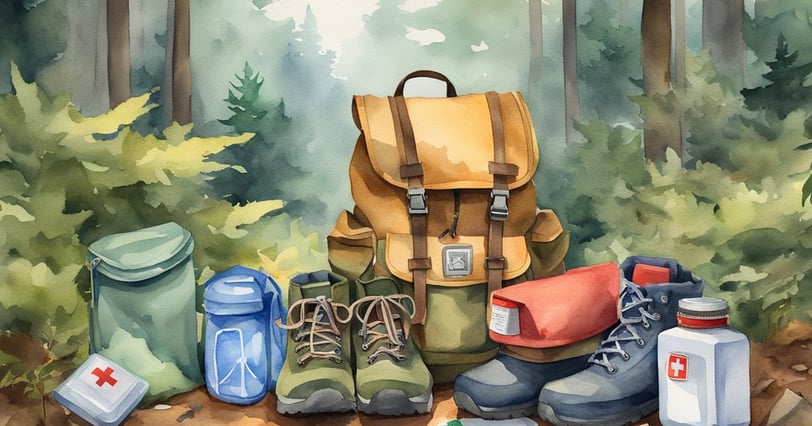Important Safety Gear to Have When Exploring the Woods: Essential Equipment for Outdoor Adventures
Exploring the woods offers an exhilarating escape into nature, but safety must always come first. Adventurers should be equipped with reliable gear to navigate potential hazards. Essential safety gear includes sturdy footwear, a first aid kit, and a navigation tool, which are crucial for any outdoor adventure.
11/26/20243 min read


Understanding the importance of proper equipment can significantly impact one's wilderness survival. Factors like changing weather conditions and challenging terrain require preparedness to ensure a safe experience in the great outdoors. From hydration packs to emergency blankets, being aware of the right tools can make all the difference when venturing into the wild.
As outdoor enthusiasts prepare for their journeys, recognizing these vital items will enhance their experience while minimizing risks. Whether trekking alone or with a group, having the correct safety gear is an investment in both adventure and peace of mind.
Core Equipment for Woodland Exploration
Proper equipment is essential for safety and comfort during woodland exploration. Key items include navigation tools, shelter and insulation options, and essential survival gear.
Navigation Tools
Effective navigation is critical in the woods. A compass and a topographic map are foundational for wilderness navigation. These tools provide crucial information about terrain, elevation changes, and potential hazards.
A GPS device can enhance traditional navigation methods. It offers real-time positioning and can store multiple waypoints. However, reliance solely on electronics is risky; batteries can fail, so having a map and compass ensures backup.
Familiarity with "leave no trace" principles also guides explorers. Knowing how to navigate responsibly helps preserve natural areas for future visitors.
Shelter and Insulation
Choosing the right shelter is vital for protection against the elements. A lightweight tarp can serve as an effective temporary shelter when needed. If camping, a well-constructed tent provides security against weather and wildlife.
Insulation is equally important for comfort. A quality sleeping bag, rated for the expected temperatures, keeps warmth during cold nights. A sleeping pad adds insulation from the ground and improves comfort.
Using a hammock can also be advantageous. It offers an elevated and comfortable sleeping option and is often easier to set up. A space blanket serves as a compact insulation solution for emergencies.
Survival Essentials
Survival gear equips individuals to handle unexpected situations. A first aid kit is necessary for addressing injuries quickly and effectively. It should include medical supplies like bandages, antiseptic wipes, and pain relievers.
A multi-tool or pocket knife proves invaluable for various tasks. It can assist in food preparation, making fire, or performing minor repairs on gear. A reliable fire starter is essential for building warmth and cooking.
Sun protection is often overlooked but crucial. Carrying sunscreen and a hat can prevent sunburn during long periods outdoors. Packing the 10 essentials ensures a well-rounded approach to safety and readiness in the wild.
Personal Safety and Comfort
When exploring the woods, personal safety and comfort are crucial for an enjoyable experience. Proper preparation can significantly reduce risks and enhance well-being.
Illumination and Fire Starters
Visibility is essential in the woods, especially as daylight fades. A reliable flashlight or headlamp equipped with extra batteries is vital for navigating trails or setting up camp after dark. LED options are recommended for their brightness and battery efficiency.
In addition to illumination, the ability to start a fire is a fundamental safety skill. Carrying fire starters such as waterproof matches, lighters, or fire starter sticks will ensure he can create a fire even in damp conditions. An emergency whistle can also serve as a signal for help if needed. Fire not only provides warmth and light but can also be crucial for signaling search and rescue personnel in emergencies.
Hydration and Nutrition
Proper hydration is critical during outdoor adventures. Bringing a water filtration system or purifying tablets ensures access to clean drinking water from natural sources. Dehydration can impair judgment and physical ability, increasing safety risks.
In addition to water, packing emergency sustenance such as energy bars or dehydrated meals will provide essential calories. Lightweight, nutrient-dense food options are ideal for maintaining energy levels. He should aim for a mix of carbohydrates, proteins, and fats to sustain him throughout the journey.
Outdoor Clothing
Wearing appropriate attire is vital for comfort and protection in diverse weather conditions. Lightweight, all-weather attire, including moisture-wicking base layers and an insulated rain jacket, will keep him dry and comfortable. Layers allow for easy adjustments based on temperature fluctuations during the day.
Additionally, a good pair of hiking boots, equipped with proper ankle support, will prevent injuries on uneven terrain. Bug repellent is also an important consideration, particularly in warmer months when insects are prevalent. It helps to prevent bites and the potential transmission of diseases, enhancing overall safety during exploration.
